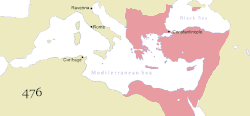
Back الإمبراطورية البيزنطية تحت حكم السلالة الإيساورية Arabic Βυζαντινή Αυτοκρατορία υπό τη Δυναστεία των Ισαύρων Greek Impero bizantino durante la dinastia isauriana Italian 이사우리아 왕조 치하의 동로마 제국 Korean ایساوری شاہی سلسلہ کے تحت بازنطینی سلطنت Urdu
Byzantine Empire | |||||||||||||
|---|---|---|---|---|---|---|---|---|---|---|---|---|---|
| 717–802 | |||||||||||||
 Map of the Eastern Roman Empire after the coronation of Charlemagne as Imperator Romanorum, 800 | |||||||||||||
| Capital | Constantinople | ||||||||||||
| Common languages | Greek Latin (in the Exarchate of Ravenna until c. 751) | ||||||||||||
| Government | Monarchy | ||||||||||||
| Emperor | |||||||||||||
• 717–741 | Leo III the Isaurian | ||||||||||||
• 741–775 | Constantine V | ||||||||||||
• 775–780 | Leo IV | ||||||||||||
• 780–797 | Constantine VI (with his mother Irene serving as regent from 780–790 and as co-ruler from 792–797) | ||||||||||||
• 797–802 | Irene of Athens (as sole ruler) | ||||||||||||
| History | |||||||||||||
• Accession of Leo III the Isaurian | 717 | ||||||||||||
• Deposition of Irene of Athens | 802 | ||||||||||||
| |||||||||||||
| History of the Byzantine Empire |
|---|
 |
| Preceding |
| Early period (330–717) |
| Middle period (717–1204) |
| Late period (1204–1453) |
| Timeline |
| By topic |
|
|
The Byzantine Empire was ruled by the Isaurian dynasty (or Syrian dynasty) from 717 to 802. The Isaurian emperors were successful in defending and consolidating the empire against the caliphates after the onslaught of the early Muslim conquests, but were less successful in Europe, where they suffered setbacks against the Bulgars, had to give up the Exarchate of Ravenna, and lost influence over Italy and the papacy to the growing power of the Franks.
The Isaurian dynasty is chiefly associated with Byzantine iconoclasm, an attempt to restore divine favour by purifying the Christian faith from excessive adoration of icons, which resulted in considerable internal turmoil.
By the end of the Isaurian dynasty in 802, the Byzantines were continuing to fight the Arabs and the Bulgars for their very existence, with matters made more complicated when Pope Leo III crowned Charlemagne as emperor of the Romans, which was seen as an attempt at making the Carolingian state the successor to the Roman Empire.
© MMXXIII Rich X Search. We shall prevail. All rights reserved. Rich X Search